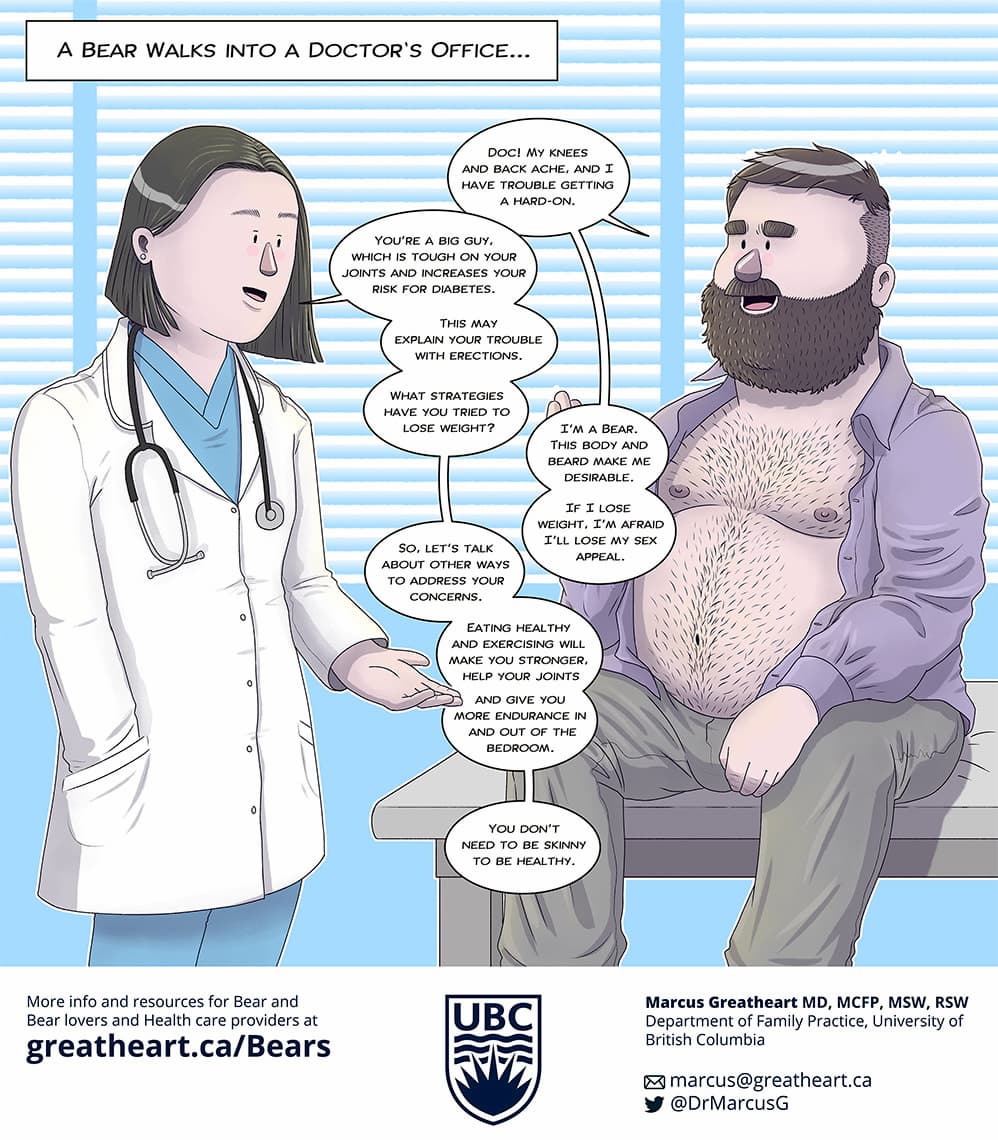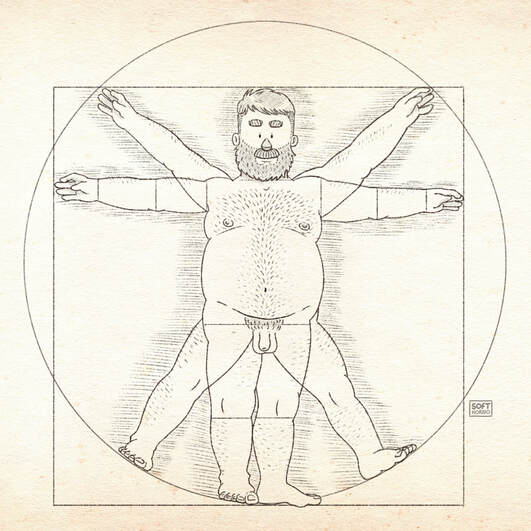health of bears
A health resource for Bears and those who love them, and their health care providers.the unique health needs of bears
Bears are a sub-group of gay men who are generally identified by their larger body size, and facial and body hair which connects them to community and with sexual partners. In the medical clinic, they are seen as obese men at increased risk for cardiovascular disease and diabetes. These conflicting perspectives were the inspiration for our project.
Together with artist & designer Horacio Abdala, we created this graphic dialogue between a Bear named Mac and his family doctor.
Mac shares with Dr. Chan his concerns about knee and back pain, and issues with erections Joint pain impacts his daily life in general, and often interferes with mobility in the bedroom. He understands that his body size puts extra stress on his body.
Regarding his erectile dysfunction, Dr. Chan explains there are a number of potential causes including diabetes and heart disease, and psychological issues like performance anxiety and depression. In some men, the excess abdominal fat may produce estrogen and affecting testosterone levels.

Dr. Chan commonly screens gay and bisexual men in her clinic for sexually transmitted infections, depression and anxiety, substance use disorders and tobacco use. In recent years she is managing HIV among positive guys, and prescribing PrEP for HIV negative people.
Just like all men over 40, Mac also needs screening for diabetes, high blood pressure and cholesterol. When he turns 50, he’ll be screened for colon cancer, in addition to an anal Pap test for HPV.
As Dr. Chan says, he doesn’t need to lose weight in order to be healthy. In fact, she learns that Mac has tried many times and struggled, and thinks a focus on getting healthier is better in the long run.
By managing his blood pressure and blood sugar, eating nutritious food, and getting some exercise he will likely see improvement in his everyday activities as well as his nighttime endeavours.
find out more
If you are interested in more information regarding health care specific to Bears, please leave your contact information and we’ll be sure to keep you updated:
[convertkit form=1987683]
health issues & screening for bears
Unique screening for Bears*
- Joint and back pain
- Hernia
- Hypogonadism
- Erectile dysfunction
- Obstructive sleep apnea
- Gout
- GERD
- Kidney stones
- Skin and soft tissue infections
Screening for gay & bisexual men
- Sexually transmitted infections
- HIV
- Syphilis
- Gonorrhea & chlamydia via urine and swabs as indicated
- Hepatitis A/B immunity
- Hepatitis C infection
- Depression & anxiety
-
- Substance use
- Tobacco
- Alcohol
- Crystal meth
- Marijuana
- Other unregulated substances
- Anal pap for HIV+ (evolving evidence for HIV-)
Screening by age and risk factor
- Cholesterol
- Diabetes
- Hypertension
- Colorectal cancer
- Lung cancer
- Pap of cervix and US chest for trans men
select references
Articles
Physical, Psychosocial, and Social Health of Men who Identify as Bears: a Systematic Review
By: Narciso Quidley-Rodriguez and Joseph P De Santis, Journal of Clinical Nursing, 25, (2016) 3484–3496, doi: 10.1111/jocn.13368
In this review, Quidley-Rodriguez and De Santis have systematically searched through the literature and found 11 articles that have looked at issues related to the health of Bears. They have summarized and grouped the findings of these articles into three categories of physical, psychosocial, and social health. They conclude that “men who identify as Bears have unique health care needs and respond to health care providers who are sensitive towards their needs. Health care providers should understand and acknowledge the unique health needs of men who identify as Bears to better care for these men.”
Bearing Bodies: Physical Activity, Obesity Stigma, and Sexuality in the Bear Community
By: Shaun E. Edmonds and Susan G. Zieff
Sociology of Sport Journal, 2015, 32, 415 -435 doi: 10.1123/ssj.2014-0166
Utilizing in-depth interviews and participant observation, the authors of this study explore the ways in which Bears negotiate physical activity and body image within the ostensibly fat-positive Bear community. In analyzing the stories and spaces of the Bear community, the researchers find diverse experiences that reveal a complex relationship between sexuality, body image, and engagement in physical activity.
Physical, Behavioral, and Psychological Traits of Gay Men Identifying as Bears
By: David A. Moskowitz, Jonathan Turrubiates, Hector Lozano, Christopher Hajek, Arch Sex Behav (2013) 42:775–784 doi: 10.1007/s10508-013-0095-z
Much of the work on understanding Bears has been through qualitative work, thus there is a scarcity of quantitative information on this topic. The authors of this study survyed gay men identifying as Bears (n = 469) to learn about their self-reported physical, behavioral, and psychological traits. In the article, they discuss matters such as sexuality, self-esteem, and inclusiveness in the Bear community.
Grow the Beard, Wear the Costume”: Resisting Weight and Sexual Orientation Stigmas in the Bear Subculture
By: Patrick B. McGrady, Journal of Homosexuality, 63:12, 1698-1725, doi: 10.1080/00918369.2016.1151695
In this article, Patrick McGrady has done a content analysis of bear-themed media and life history interviews with self-identified bears. Through those, he aims to gain an understanding of the stigma that comes with coming out as gay and being overweight, and how the Bears are resisting this stigma by empowering their communities and celebrating their bodies.
Articles
Physical, Psychosocial, and Social Health of Men who Identify as Bears: a Systematic Review
By: Narciso Quidley-Rodriguez and Joseph P De Santis, Journal of Clinical Nursing, 25, (2016) 3484–3496, doi: 10.1111/jocn.13368
In this review, Quidley-Rodriguez and De Santis have systematically searched through the literature and found 11 articles that have looked at issues related to the health of Bears. They have summarized and grouped the findings of these articles into three categories of physical, psychosocial, and social health. They conclude that “men who identify as Bears have unique health care needs and respond to health care providers who are sensitive towards their needs. Health care providers should understand and acknowledge the unique health needs of men who identify as Bears to better care for these men.”
Bearing Bodies: Physical Activity, Obesity Stigma, and Sexuality in the Bear Community
By: Shaun E. Edmonds and Susan G. Zieff
Sociology of Sport Journal, 2015, 32, 415 -435 doi: 10.1123/ssj.2014-0166
Utilizing in-depth interviews and participant observation, the authors of this study explore the ways in which Bears negotiate physical activity and body image within the ostensibly fat-positive Bear community. In analyzing the stories and spaces of the Bear community, the researchers find diverse experiences that reveal a complex relationship between sexuality, body image, and engagement in physical activity.
Physical, Behavioral, and Psychological Traits of Gay Men Identifying as Bears
By: David A. Moskowitz, Jonathan Turrubiates, Hector Lozano, Christopher Hajek, Arch Sex Behav (2013) 42:775–784 doi: 10.1007/s10508-013-0095-z
Much of the work on understanding Bears has been through qualitative work, thus there is a scarcity of quantitative information on this topic. The authors of this study survyed gay men identifying as Bears (n = 469) to learn about their self-reported physical, behavioral, and psychological traits. In the article, they discuss matters such as sexuality, self-esteem, and inclusiveness in the Bear community.
Grow the Beard, Wear the Costume”: Resisting Weight and Sexual Orientation Stigmas in the Bear Subculture
By: Patrick B. McGrady, Journal of Homosexuality, 63:12, 1698-1725, doi: 10.1080/00918369.2016.1151695
In this article, Patrick McGrady has done a content analysis of bear-themed media and life history interviews with self-identified bears. Through those, he aims to gain an understanding of the stigma that comes with coming out as gay and being overweight, and how the Bears are resisting this stigma by empowering their communities and celebrating their bodies.
Books
Fat Gay Men: Girth, Mirth, and the Politics of Stigma, by Jason Whitesel
Jason Whitesel delves into the world of Girth & Mirth, a nationally known social club dedicated to big gay men, illuminating the ways in which these men form identities and community in the face of adversity.
Faeries, Bears, and Leathermen: Men in Community Queering the Masculine by Peter Hennen
Over time, male homosexuality and effeminacy have become indelibly associated, sometimes even synonymous. In Faeries, Bears, and Leathermen, Peter Hennen contends that this stigma of effeminacy exerts a powerful influence on gay subcultures. Through a comparative ethnographic analysis of three communities, Hennen explores the surprising ways that conventional masculinity is being collectively challenged, subverted, or perpetuated in contemporary gay male culture.
Books
Fat Gay Men: Girth, Mirth, and the Politics of Stigma, by Jason Whitesel
Jason Whitesel delves into the world of Girth & Mirth, a nationally known social club dedicated to big gay men, illuminating the ways in which these men form identities and community in the face of adversity.
Faeries, Bears, and Leathermen: Men in Community Queering the Masculine by Peter Hennen
Over time, male homosexuality and effeminacy have become indelibly associated, sometimes even synonymous. In Faeries, Bears, and Leathermen, Peter Hennen contends that this stigma of effeminacy exerts a powerful influence on gay subcultures. Through a comparative ethnographic analysis of three communities, Hennen explores the surprising ways that conventional masculinity is being collectively challenged, subverted, or perpetuated in contemporary gay male culture.
the artist
Horatio Abdala
A graphic designer and illustrator from Buenos Aires, Horacio began to specialized in queer images about 4 years ago.
“I identify 100% with the images and I feel that many other people also feel the same.”
Drawings collected on his Instagram portfolio called SOFT HORNO attempt to show the most sensitive part of men. In contrast, HORNO shows the most sexual part, focusing on an artistic vision of sex with hints of humour.
Horatio Abdala
A graphic designer and illustrator from Buenos Aires, Horacio began to specialized in queer images about 4 years ago.
“I identify 100% with the images and I feel that many other people also feel the same.”
Drawings collected on his Instagram portfolio called SOFT HORNO attempt to show the most sensitive part of men. In contrast, HORNO shows the most sexual part, focusing on an artistic vision of sex with hints of humour.


